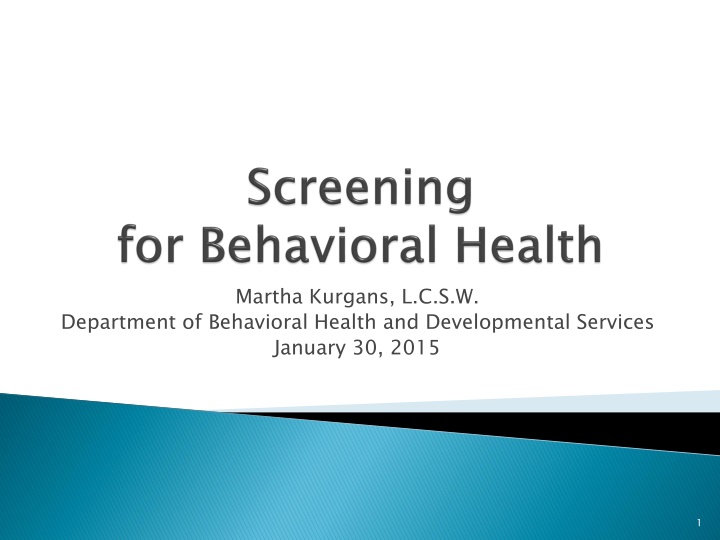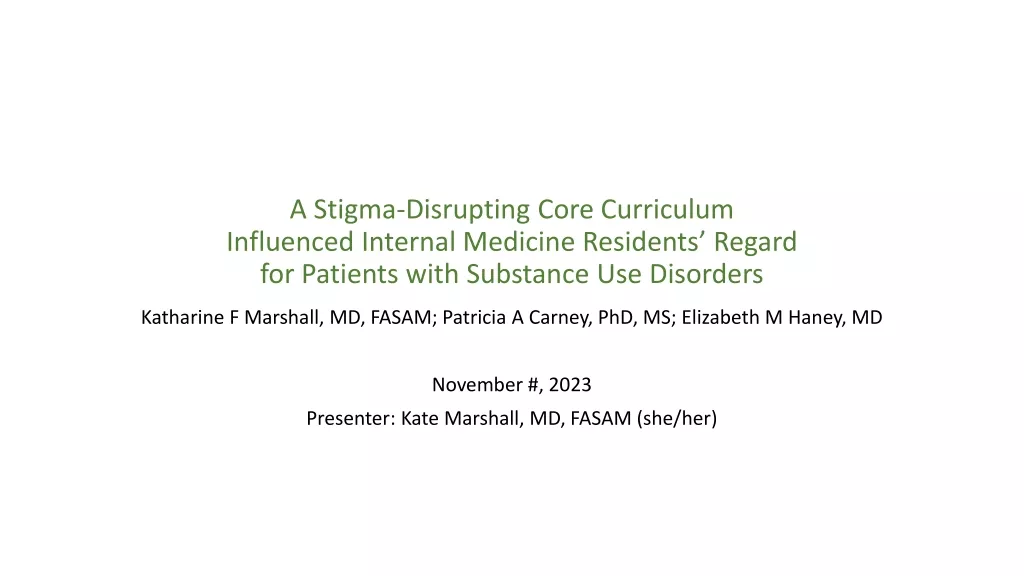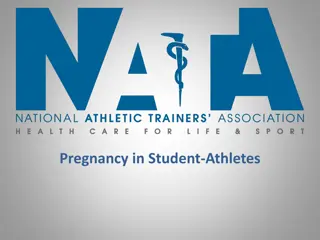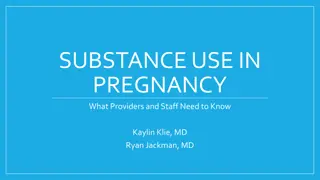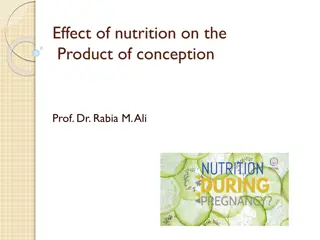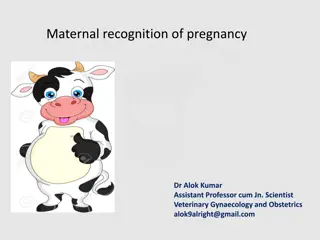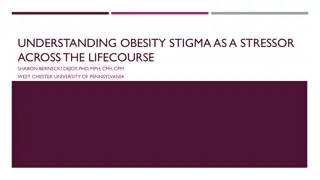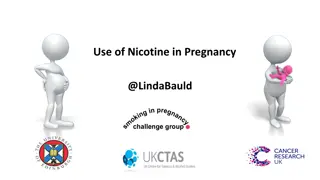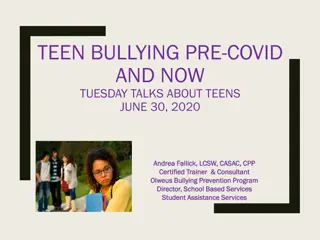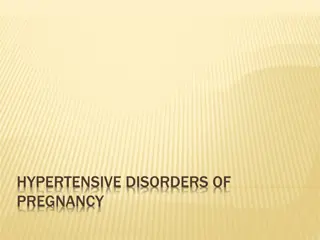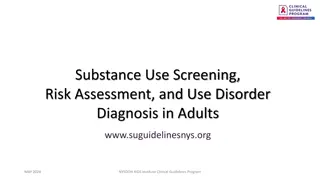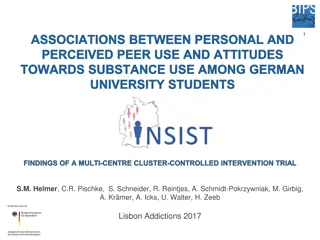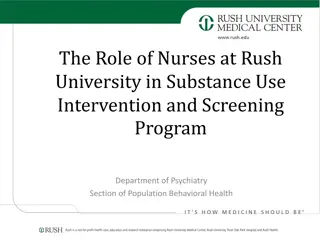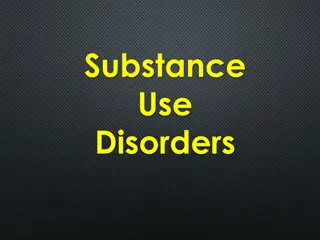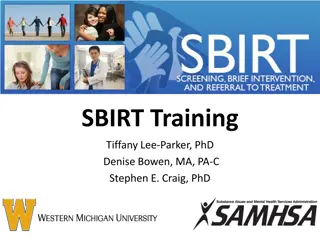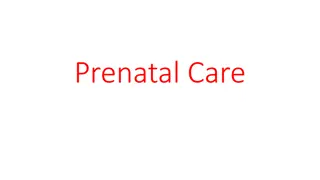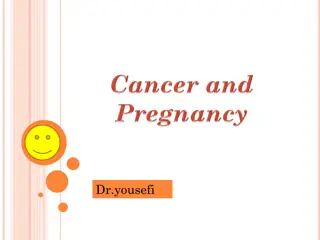Substance Use and Pregnancy Risks
Substance use, emotional problems, and intimate partner violence pose significant health risks to pregnant women and their newborns. Routine screening is vital to identify and address these risks early on. Failure to implement proper identification and referral to treatment may lead to adverse outcomes, including maternal and infant deaths.
Download Presentation

Please find below an Image/Link to download the presentation.
The content on the website is provided AS IS for your information and personal use only. It may not be sold, licensed, or shared on other websites without obtaining consent from the author.If you encounter any issues during the download, it is possible that the publisher has removed the file from their server.
You are allowed to download the files provided on this website for personal or commercial use, subject to the condition that they are used lawfully. All files are the property of their respective owners.
The content on the website is provided AS IS for your information and personal use only. It may not be sold, licensed, or shared on other websites without obtaining consent from the author.
E N D
Presentation Transcript
Martha Kurgans, L.C.S.W. Department of Behavioral Health and Developmental Services January 30, 2015 1
Substance use, emotional problems and intimate partner violence threaten the health and safety of women and their newborns. Women who experience one or more of these problems are often reluctant to acknowledge it. These risks often co-occur - placing women at even greater risk. The best way to identify who is at risk is to routinely screen all women at regular intervals. 2
Pregnant women are at greater risk to experience depression and/or domestic violence than non- pregnant women. Pregnant women who use drugs and alcohol place their unborn infant at risk. 2013 National Survey Drug Use and Health (NSDUH): Substance Use During Pregnancy Alcohol use: 9.4% (VA=9,575)* Tobacco use:15.4% (VA=15,687)* Illicit drug use: 5.4% (VA=5,501)* 3
During Pregnancy During Pregnancy 2007 2007 2008* Physical abuse: 4.8% Alcohol use: 8.6% Tobacco use:12.5% Reported depression: 26% 2008* 2010 2010 - -2011* Physical abuse: 3.4 % Alcohol use:11.5% Tobacco use: 8.3 % 2011* 4
Sleep Related Infant Deaths in Virginia (2014), Child Fatality Review Team Reviewed 119 cases of sleep related infant deaths; determined substance use was a major factor that contributed to these deaths. Sleep Related Infant Deaths in Virginia (2014), Child Fatality Review Team : Maternal Mortality Review Team their report on unintentional overdose Reviewed 397 cases of maternal deaths that occurred between 1999-2007. Determined that substance use contributed to 96 of these deaths (24.4%). 41 of the 397 women overdosed (10%); 34 of these overdoses were unintentional. Maternal Mortality Review Team will soon release 5
Earlier identification of substance use and referral to treatment might have prevented these deaths. Providers failed to implement Virginia laws which were designed to identify and refer pregnant and postpartum substance using women to needed treatment and services. 6
SBIRT individuals who may have or be at risk to develop a substance use disorder (S.U.D.) SBIRT : : a public health model intended to identify SBIRT identifies those at risk of developing substance use disorders and provides brief intervention on the spot. 7
Draws on principles of motivational interviewing when conducting a brief intervention Builds upon the idea that those with few problems or mild problems who are at risk may benefit from a brief intervention with a non-substance abuse specialist Acknowledges that those with significant problems usually need specialty care, like addiction treatment services and encourages their referral to specialty care. 8
Model can also be used to identify and refer individuals who experience other behavioral health risks Emotional problems, including perinatal depression Intimate partner violence Tobacco use In Virginia, SBIRT has already been used in primary care, mental health, and community settings to intervene with women who may have co-occurring behavioral risks. 9
Screening identify if a woman may have a behavioral health problem. Screening: Administer a brief screening tool that can Brief Intervention minutes, elicit the woman s perspective on her problem and what risks she may experience if her situation continues and doesn t change. The intervention is matched to her level of knowledge and motivation. Only bits of information are provided to supplement what she knows. No pushing or arguing is involved. Invite her to discuss again at next visit. Brief Intervention: If she screens as at risk , in 3-5 Referral to Treatment having a problem and is receptive to being referred, refer her for an assessment to determine appropriate treatment and services. Referral to Treatment : : If she screens as dependent/ 10
Screening: A standardized set of questions you ask not a medical test, exam or history. Indicates whether a thorough assessment is needed. Does not determine a diagnosis or what type of treatment is needed Can be completed by a variety of service providers Screening: 11
A Substance Use or Mental Health Assessment m (QSP) in that field A Substance Use or Mental Health Assessment must be completed by a qualified service provider To determine an individual s diagnosis and develop an initial treatment plan, the QSP obtains a comprehensive history of their past and current functioning other related problems and risks social supports and motivation 12
A brief instrument or set of questions that is intended to detect the possibility of a problem Cannot diagnosis a problem but can indicate if further assessment is needed Ideally, it should be: Brief and easy to use Inexpensive Non-intrusive Tested (validated) on the population its to be used with Within the expertise of a wide range of professionals 13
Screen all clients Screen for substance use, emotional health and intimate partner violence Screen periodically Utilize a standard tool or protocol Ask questions in a health context this lessens the stigma Use everyday language; be honest and direct Use a positive, non-judgmental and non- confrontational approach all clients 14
Substance use, mental health (including depression) and tobacco use Behavioral Health Screening Tool Substance use, mental health (including perinatal depression) and tobacco use: Virginia s perinatal Substance Use Mental Health Perinatal Scale Intimate Partner Violence Substance Use : 4 P s or 5 P s Mental Health: PHQ2 or PHQ9 Perinatal Depression: le or Edinburgh 3 Intimate Partner Violence : AAS or WEB/RAT Depression: Edinburgh Depression 15
Simple, effective way to screen women for high risk behaviors, tobacco use and perinatal depression all at one time. Combines validated screening tools The 5Ps screens for substance use in women The Edinburgh 3 screens for perinatal depression Questions on intimate partner violence (IPV). Can be provider or self administered. Available in 3 languages. 16
Providing a Brief Intervention
The SBIRT model incorporates Motivational Interviewing (MI), a method to have a constructive conversation about change. MI is based on the belief that people are ambivalent about change and continue harmful behaviors because of their ambivalence. MI helps people resolve their ambivalence and increase their motivation to change. Motivation for change can be fostered by an accepting, empowering, and safe atmosphere 18
Empathy (provide support) Develop Discrepancy (encourage individuals to question their own behavior) Roll with Resistance (don t argue) Support Self-efficacy (empower) No matter whether you re addressing substance use, intimate partner violence or a mental health concern, the same MI principles apply. 19
Most women want what is best for their baby Sometimes, education alone can be sufficient to promote change Even brief interventions can trigger change. Assess the problem, her motivation to make changes and adjust the intervention, Set appropriate goals with her. If additional services are needed, a warm handoff will ensure a successful referral. 20
Providers should be familiar with Treatment resources community and how to access them. Community support services that can help individuals overcome barriers they may experience related to transportation, child care and/or funding. Treatment resources available in their Community support services Federal confidentiality state legislation that may impact on their patients and be prepared to discuss them. Federal confidentiality regulations as well as 21
Community Service Boards: provide public mental health, substance use, and intellectual disabilities services Required to provide gender specific outpatient substance use treatment to pregnant & parenting women Pregnant substance using women receive treatment priority. Must be seen within 48 hrs of their request for services. Services for perinatal depression may be more difficult to access 6 women s residential substance abuse treatment programs in the Commonwealth accept pregnant women Crisis stabilization units (CSU s) will accept pregnant women 22
Explain the referral process, the importance of sharing information and their role coordinating the woman s treatment with the new provider Explore and address any questions or concerns their patient might have about the referral as well as how it will or won t affect their work with her. Discuss confidentiality. Have the woman sign a release so they can make the referral and share critical information. Encourage the woman to sign a release with the new provider as well so they will also be able to share information. Assist the woman and help her make the appointment. Provide support and encouragement. 23
Follow up to be sure she contacted the organization, received necessary services and was helped. Continue to support the woman s efforts, provide encouragement and support any positive efforts to change Periodically, check back . Stressors and events in her life may change over time. 24
Training regarding SBIRT and implementing M.I. techniques is available through face to face and web based instruction. The SBIRT process gets easier and quicker with practice. The more often providers screen individuals the more comfortable they will become using this approach. Screening is intended to stimulate open discussion between patient and providers 25
Recognize and support her accomplishments Educate her regarding the importance of remaining risk free. Based on what you ve said today, it seems like you are not at high risk of substance use problems. This could change, and if it does, let me know if you want to talk about it. Let her know that help is available if something changes. 26
Screening is intended to encourage discussion between a woman and her provider These are very difficult issues to discuss. What s most important is that women know their provider is familiar with these issues and is willing and able to talk about them. As women develop trust in their treatment provider, they may be more able to acknowledge their problems and share concerns. 27
Continue to encourage her to follow through with recommended referrals. Empathize with her struggle Convey a clear interest in her and her effort Help her set achievable goals Support any positive attempts to change Avoid arguments. The client should be the one arguing for change. Acknowledge that now may not be the best time, but invite her to talk further at another visit. 28
Medicaid will reimburse for substance abuse screening and brief intervention services 3 times per year per provider CPT99408 (>15 min) =$25.84 CPT99409 (>30min) = $50.38 Client must be Medicaid eligible; Provider must be Medicaid approved. Provider must use a DMAS approved substance use screening tool and document their intervention 29
Screening tools & guidance are available on the DBHDS website http://www.dbhds.virginia.gov/individuals-and- families/substance-abuse/substance-abuse- screening/pregnant-women-childbearing-age Virginia s Home Visiting Consortium (HVC) provides a skill based series for home visitors on Screening and Brief Intervention Why Screen? (web based) Motivational Interviewing (1 day training) SBIRT for Risky Health Behaviors (1 day training) 30
SBIRT/ Substance Abuse and Mental Health Services Administration http://www.samhsa.gov/sbirt SBIRT CORE Training Program http://www.sbirttraining.com SAMSHA HRSA Center for Integrated Health Solutions http://www.integration.samhsa.gov/clinical-practice/sbirt The Big Hospital SBIRT Initiative http://hospitalsbirt.webs.com/webinars.htm 31
Behavioral health (substance use, tobacco use, emotional health, intimate partner violence) impacts on maternal and fetal outcomes. Women are receptive to screening when done in a health context and presented in a nonjudgmental manner. Use screening tools suited for pregnant women. Screening enables providers to intervene before women experience more serious consequences. 32
